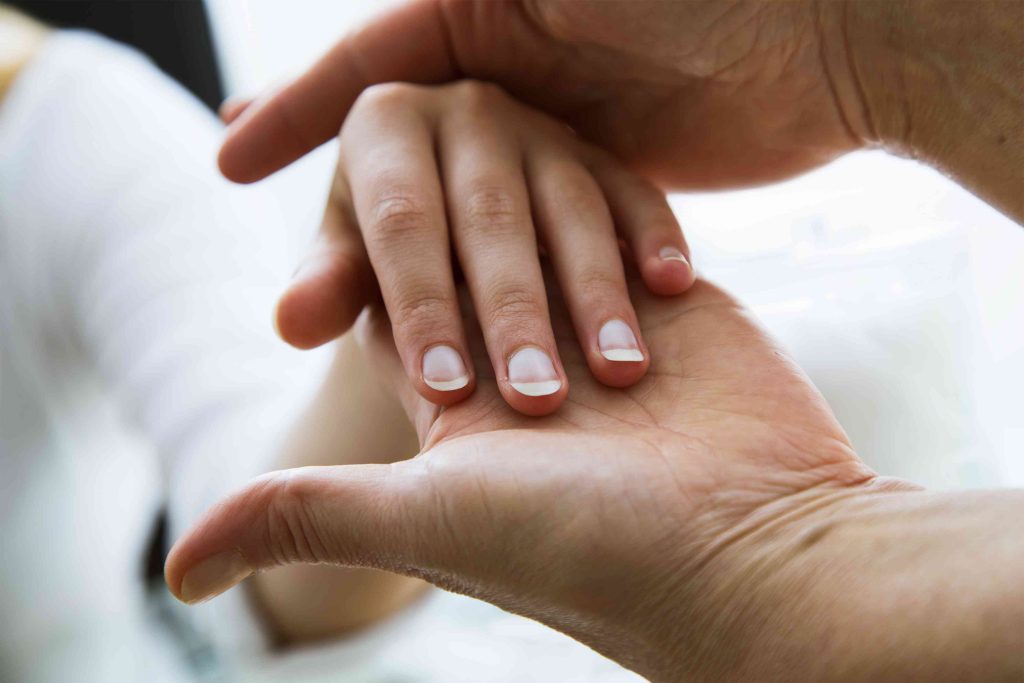:max_bytes(150000):strip_icc():format(jpeg)/Health-GettyImages-183284293-c6ed8afdf5d14ce6a1607ca0d63d9556.jpg)
Clubbed nails, also known as digital clubbing or Hippocratic fingers, describe a downward slope or curve in your fingernails or toenails. This condition develops gradually and can become chronic (long-lasting) without treatment.
Clubbed nails can run in some families and are harmless, but an estimated 40% of the time, they are a symptom of an underlying disease or disorder.
Since clubbed nails can signal a more serious condition, it’s important to seek medical care for a proper diagnosis if you experience this symptom.
Reproduced with permission from © DermNet and © Raimo Suhonen dermnetnz.org.
Clubbed nails can affect your fingers or toes and cause a distinctive, round appearance of the nail. Depending on the case, you may have symptoms in a few or all of your nails.
Swelling in the tissue under your nail causes the nail to push out close to the nail matrix (the white part at the base of the nail). Eventually, the nail bends, making a curve that looks like an upside-down spoon running toward the end of the finger or toe.
The tip of your finger may become swollen, warm, and red and start bulging out. Affected nails can feel looser and more springy or flexible when you push down on them. These nails may also have ridges down their length.
Research suggests clubbed fingernails result from a buildup of certain cells and the development of extra blood vessels in the tissues below the finger or toenails.
Primary clubbing describes clubbed nails that occur on their own without a known cause. Secondary clubbing is when clubbed nails are a symptom of a serious underlying condition, most often of the lungs, heart, or liver, causing decreased blood flow.
Primary Clubbing
Primary clubbing is an inherited trait that people are born with, passed down from parent to child. It’s more of a feature than a symptom, and this type is not a sign of serious disease.
Hypertrophic osteoarthropathy (HOA) is a rare congenital cause of primary clubbing, which researchers have attributed to mutations in two genes. In addition to clubbing, this condition can cause new bone growth at the end of long bones, such as the tibia (the long bone of the lower leg).
Lung and Chest Conditions
The most common causes of secondary clubbing are lung conditions. Lung conditions associated with clubbed fingernails include:
- Lung cancer: About 80% of secondary cases are triggered by lung cancer. Not everyone with lung cancer will develop clubbed fingernails, though. This symptom appears in about 5-15% of people with lung cancer.
- Pleural tumor (mesothelioma): Mesothelioma is cancer in the pleural cavity, the space between the lungs and thoracic (chest) walls. Typical signs include chest pains, cough, difficulty breathing, and trouble swallowing.
- Interstitial lung disease: This is a set of diseases that cause scarring in the lungs. Medications, genetics, and autoimmune diseases like sarcoidosis or rheumatoid arthritis can all cause interstitial lung disease. Symptoms include shortness of breath, dry cough, fatigue, and weight loss.
- Cystic fibrosis: This is a progressive, inherited disease that causes mucus buildup in the lungs. Cystic fibrosis leads to wheezing, abnormal heart rhythm, chest infections, coughing up blood, and other symptoms.
Heart and Blood Vessel Conditions
Diseases impacting the heart and blood vessels can also lead to clubbing. Common heart and blood vessel diseases that may cause clubbing include:
- Congenital heart disease: This is a heart condition acquired at birth. It may cause bluish coloring of the skin, especially in your lips, fingers, and toes.
- Infective endocarditis is a bacterial infection of the tissues inside the heart, often in the valves. It can cause fever, chills, night sweats, fatigue, muscle and joint aches, and swelling.
- Aortic aneurysm: An aortic aneurysm occurs when a bulge forms in the aorta, the large artery that carries oxygen from the heart. Although it may cause no symptoms at first, the artery can burst, causing dangerous or even fatal complications.
Gastrointestinal Diseases
Clubbing in the fingers or toes can also be a sign of diseases affecting the liver and gastrointestinal tract, such as liver cirrhosis and inflammatory bowel disease (IBD).
Liver cirrhosis is scarring and inflammation of the liver. It can also cause clubbed fingers and toes. It occurs due to infections like hepatitis and excessive alcohol or drug use. Cirrhosis can cause jaundice (yellowing of the skin and eyes), itchy skin, fatigue, weakness, nausea and vomiting, and weight loss.
Inflammatory bowel disease (IBD), including Crohn’s disease and ulcerative colitis, causes chronic inflammation of the bowels and large intestines. Alongside clubbed fingernails and toenails, IBD symptoms include diarrhea, abdominal pain, nausea, fatigue, and unintended weight loss.
Other Diseases
Several other serious diseases can also cause clubbed toenails or fingernails.
Hodgkin lymphoma is a rare cancer that affects the lymphatic system, which helps regulate your immune system. It causes swollen lymph nodes in your armpit, neck, and groin, with symptoms including fever, chills, night sweats, itchiness, and unintended weight loss.
Human immunodeficiency virus (HIV) is a sexually transmitted infection that attacks the immune system. HIV/AIDS raises the risk of a range of infections. About 30% of people with HIV may have clubbed fingers.
Clubbed fingernails can be signs of serious and life-threatening conditions, so any symptom warrants medical attention.
If your nails change shape or become rounder and softer, it’s important to call your healthcare provider. This is especially true if you also have unexpected weight loss, joint swelling, or lung-related symptoms such as a dry cough, wheezing, or chest pains.
Your healthcare provider will ask about your medical history and examine your nails. They’ll assess your symptoms and, if needed, perform tests to determine the underlying cause of your nail clubbing. Your provider may perform an X-ray or computerized tomography (CT) scan to examine your chest, lungs, and heart.
Primary finger or toenail clubbing cases are typically harmless and don’t require treatment. However, in most secondary cases, when clubbed nails are a sign of an underlying disease, treatment of that condition is critical.
There is no direct cure for clubbing. Instead, treatments focus on the condition causing the clubbing. Fingernail or toenail clubbing may or may not improve once the underlying cause resolves.
For clubbing associated with hypertrophic osteoarthropathy, therapies to ease symptoms may include medications like prescription nonsteroid anti-inflammatory drugs (NSAIDs) to decrease pain and inflammation and bisphosphonates to help with bone pain.
There’s no way to prevent primary clubbed fingernails, but certain lifestyle changes can help prevent potential causes of secondary clubbed fingernails, such as lung, heart, or liver disease. Several strategies may help:
- Get regular physical activity or exercise
- Avoid smoking and exposure to second-hand smoke
- Wear a protective mask if you’re working with harsh chemicals, asbestos, construction materials, or other potential irritants
- Avoid exposure to radiation or radioactivity
- Limit or stop alcohol use
- Avoid illicit drug use
- Practice safe sex
- Maintain a healthy weight, as determined by you and your healthcare provider
Clubbed fingernails occur when the tissue under your toenails or fingernails becomes inflamed and soft, giving the nail a round, swollen appearance.
This condition can occur on its own with no serious health problem or indicate a serious underlying disease, such as lung cancer or cirrhosis.
While there is no way to directly treat finger or toenail clubbing, managing the underlying cause may help your nails regain their regular appearance.








